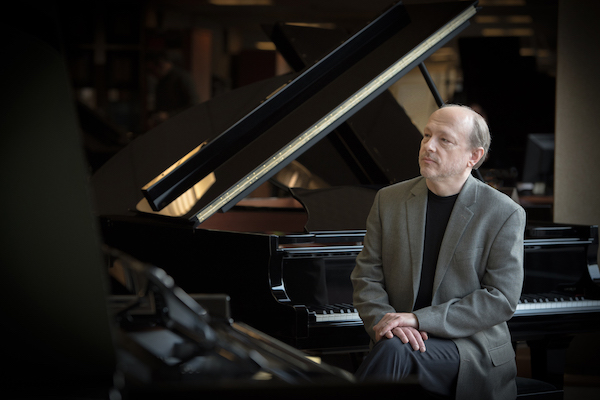Hamelin’s natural eloquence is manifest in music of Beethoven, Fauré and Hamelin

Marc-André Hamelin performed a recital for the Candlelight Concert Society Saturday night. Photo: Sim Cannety-Clarke
There’s a clichéd line about rock musicians—something about guitar players who have technical skill but aren’t loved because they don’t have the “feel” that less proficient players have.
That’s nonsense, of course. Feel is expression, playing what you feel, and the more command a musician has on their instrument the more direct the line between feeling and sound.
Pianist Marc-André Hamelin is a living example of that, and he demonstrated it again Saturday night in a recital (viewed via livestream) presented by the Candlelight Concert Society, in Linehan Hall at the University of Maryland, Baltimore County. Hamelin played one of the most difficult pieces in the repertoire, Beethoven’s “Hammerklavier” Sonata, No. 29, Op. 106, along with short works by Fauré and the pianist’s own composition, Suite à l’ancienne.
There are so many things that make the “Hammerklavier” a challenge: the speed at which the hands have to cover broad distances on the keyboard, the work’s length and intensity—especially in the massive fugue in the finale—all of which demand more physical and mental focus than nearly any other piece in the repertoire. There has probably never been a technically perfect live performance, and Hamelin had the occasional minor misstep, which in the context was irrelevant.
The experience of this piece in concert often means listening to how the pianist is playing it. With Hamelin’s command, one listened to the music he was making and to what Beethoven had to say, because Hamelin’s skill meant that the piece’s eloquence was manifest.
His playing was calm and poised, clear expression without overstatement, and a strong and flexible sense of connection between movements and within them. There was a subtle elision between the primary and secondary subjects in the opening movement, which, despite its length seemed to take no time at all—not hurrying in any way, but so simple that it felt completely cogent.
The Scherzo is already tidy, and Hamelin’s unmannered playing, the strong feeling that he knew exactly what he wanted to say and said it exactly, continued through the deep thinking and moods of the Adagio sostenuto. Where other pianists linger on each passing chord and Beethoven’s modulations, Hamelin folded those under a large-scale horizontal flow, as if the entire movement fell under one single, extended legato marking.
This flow, with increased energy, continued in the finale. Hamelin neither lingered on the simpler passages nor used them as physical and mental preparation for the complex music that followed. Nor did he get bogged down in the fugal variations. Playing with more weight than in the previous movements, his long line and forward motion never wavered. Hearing this kind of motion in the “Hammerklavier,” the relative sense of lightness, was something new.
After intermission, Hamelin opened with music of Fauré—the Barcarolle No. 1 in A Minor, Nocturnes Nos. 2 and 12, in B major and E Minor respectively, and Barcarolle No. 6 in E-Flat Major. These are so infrequently heard that they came off as new and were a real pleasure. Hamelin’s skill and clarity mean that Beethoven could be absolutely transparent and sound like Beethoven, and Fauré could be just as transparent and sound like the apotheosis of French music. With softly etched articulation and subtle inflections, the performances were flexible and smooth, like water with the something of the malleability of taffy. His sound was resonant and limpid, with beautiful touches of rubato in the phrasing and rhythms. There was the right amount of energy in the Barcarolles, strong but never too intense, and the Nocturnes were poetic.
Hamelin’s own piece, written in 2020, was both odd and fascinating. In six sections with archaic titles like “Corrente” and “Gavotte et musette,” it opened with enough random chaotic gestures that one feared this was going to a a confused, hyperactive Frankenstein monster of a piece, like a computer generating every difficult thing a piano player could do. But after that “Préambule,” the music settled down to a straightforward and charming jaunt that sounded much more like it came out of Gershwin than any French tradition, what with the seventh chords, mid-20th century dance rhythms, and song-like phrasing that sauntered in and out. Ancient music though? Well, Tin Pan Alley was over a hundred years ago, so it’s all relative.
After the warm applause, Hamelin sat down for an encore. He said “Debussy” to the audience, and then played a measured, thoughtful and ravishing “Reflets dans l’eau.”
Behzod Abduraimov plays Ravel, Rachmaninoff, Prokofiev and more, 7:30 p.m., January 21 in the Candlelight Concert Society series. candlelightconcerts.org



